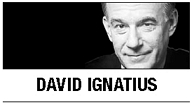DAVOS, Switzerland ― A sign of the concern among business and political leaders here about sluggish economic growth is that one of the World Economic Forum sessions last week was titled “Avoiding a Centennial Slump” ― meaning a downturn that lasts a hundred years.
Few are quite that gloomy. But “secular stagnation,” as Lawrence Summers, the Harvard economist and former treasury secretary terms it, is a pervasive  worry. Among the warning signs was this week’s downgrade by the International Monetary Fund of its global growth forecasts to 3.5 percent for this year and 3.7 percent in 2016. The European Union is forecasting anemic growth of just 1.2 percent to 1.4 percent this year and 1.7 percent next.
worry. Among the warning signs was this week’s downgrade by the International Monetary Fund of its global growth forecasts to 3.5 percent for this year and 3.7 percent in 2016. The European Union is forecasting anemic growth of just 1.2 percent to 1.4 percent this year and 1.7 percent next.
The European Central Bank did the equivalent of pushing the panic button Thursday, announcing a massive 1.1 trillion euro program of bond-buying meant to lower interest rates and encourage investment. That’s larger than many analysts had predicted. But rates are already rock-bottom, and while the ECB’s “quantitative easing,” as it’s known, will flood Europe with cash, there’s no guarantee it will be used to cure the region’s structural impediments to growth. Indeed, persistent low rates are one of the attributes of a deflationary economy, rather than a cure.
“Structural reforms must be carried forward. It must be carried through, no matter how difficult, to generate new momentum for global development,” Chinese Prime Minister Li Keqiang warned. China is part of the slowdown story, too, with its growth slipping last year to 7.4 percent, the lowest level in 24 years. Li talked like a Chamber of Commerce booster, trying to reassure the audience that the Chinese engine was still strong. He promised less regulation, better market access, more competition, less corruption, more tolerance for failure ― in short, structural reforms.
Against this background of global growth anxiety, the program of “middle class economics” announced by President Obama in his State of the Union address Tuesday looks pretty solid. Politically, it’s probably a nonstarter with a GOP-run Congress whose main ambition seems to be making the president’s life difficult for the next two years. But Obama’s program includes the sort of details that many economists argue would be needed to overcome the structural impediments to faster growth in the U.S.
The tax-the-rich aspects of Obama’s plan have attracted the most attention. But most of his proposals deal with the trickier problem of encouraging lower-income Americans to get the skills and jobs that will make a middle-class life possible. This includes tax credits for families with young children; more government support for preschool education; lower mortgage premiums for first-time home buyers; and paid sick leave for the 43 million workers who don’t have it.
Economists argue that a real structural change in the U.S. economy requires higher levels of education and job training. Obama’s plan focused on this aspect of transition, proposing two free years of community college for students who have good grades, on-the-job training and new transition programs for workers who want to move to higher-paying jobs.
There was old-fashioned Keynesian pump-priming in the president’s program, too, with its proposal for a “Grow America Act” to spend money on the country’s decaying infrastructure, financed by reform of corporate taxes to cut loopholes and prevent companies from hiding money offshore. There’s a misconceived notion that Keynesian ideas about fiscal policy are outdated. The path of the global economy since the 2008 crash shows the opposite: Nations that provided fiscal stimulus for their economies are doing far better than the ones that opted for austerity.
Americans should take some confidence from the fact that the U.S. economy is seen here as having rebounded from its near-death experience of 2008. It is growing much faster than Europe’s or Japan’s, its currency is strong, its financial markets are solid and well-regulated. U.S. political leaders bicker incessantly, but both parties agree on the need for policies that expand trade and reduce barriers to economic growth. Europe and Japan are far behind on such issues.
“Uncertainty” overhangs the global economy, warns Swiss President Simonetta Sommaruga. Business leaders can’t forecast oil prices, currency movements or political trends. With the future so cloudy, trillions of dollars in cash is sitting on the sidelines, waiting for clarity.
The specter haunting Davos this year was deflation ― the prospect that Europe and Japan will suck the rest of the world into a period of declining prices where nobody wants to spend or invest today because it will be cheaper tomorrow. “It’s an annihilation,” said one American investment manager of the deflation threat. “It’s Darth Vader, [the] death star outside of the atmosphere of the Earth, shooting lasers to blow up the world’s economy.”
By David Ignatius
David Ignatius’ email address is davidignatius@washpost.com. ― Ed.
(Washington Post Writers Group)
-
Articles by Korea Herald







![[Graphic News] More Koreans say they plan long-distance trips this year](http://res.heraldm.com/phpwas/restmb_idxmake.php?idx=644&simg=/content/image/2024/04/17/20240417050828_0.gif&u=)
![[KH Explains] Hyundai's full hybrid edge to pay off amid slow transition to pure EVs](http://res.heraldm.com/phpwas/restmb_idxmake.php?idx=644&simg=/content/image/2024/04/18/20240418050645_0.jpg&u=20240419100350)






![[From the Scene] Monks, Buddhists hail return of remains of Buddhas](http://res.heraldm.com/phpwas/restmb_idxmake.php?idx=652&simg=/content/image/2024/04/19/20240419050617_0.jpg&u=20240419175937)

![[KH Explains] Hyundai's full hybrid edge to pay off amid slow transition to pure EVs](http://res.heraldm.com/phpwas/restmb_idxmake.php?idx=652&simg=/content/image/2024/04/18/20240418050645_0.jpg&u=20240419100350)

![[Today’s K-pop] Illit drops debut single remix](http://res.heraldm.com/phpwas/restmb_idxmake.php?idx=642&simg=/content/image/2024/04/19/20240419050612_0.jpg&u=)